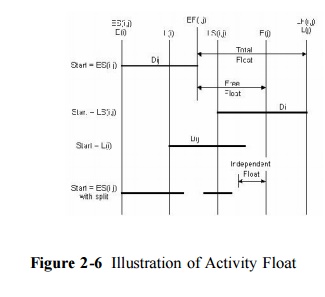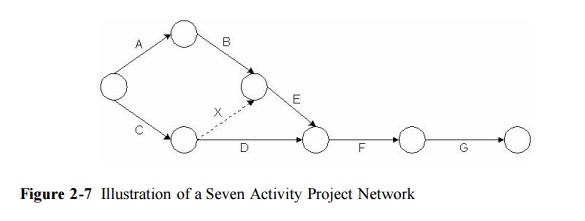Chapter: Civil : Construction Planning And Scheduling
Activity Float and Schedules

Civil - Construction Planning And Scheduling:
Activity
Float and Schedules
A number of different activity schedules can be
developed from the critical path scheduling procedure described in the previous
section. An earliest time schedule would be developed by starting each activity
as soon as possible, at ES(i,j). Similarly, a latest time schedule would delay
the start of each activity as long as possible but still finish the project in
the minimum possible time. This late schedule can be developed by setting each
activity's start time to LS(i,j).
Activities that have different early and late
start times (i.e., ES(i,j) < LS(i,j)) can be scheduled to start anytime
between ES(i,j) and LS(i,j) as shown in Figure 10-6. The concept of float is to
use part or all of this allowable range to schedule an activity without
delaying the completion of the project. An activity that has the earliest time
for its predecessor and successor nodes differing by more than its duration
possesses a window in which it can be scheduled. That is, if E(i) + Dij
< L(j),
then some
float is available in which to schedule this activity.

Float is a very valuable concept since it
represents the scheduling flexibility or "maneuvering room" available
to complete particular tasks. Activities on the critical path do not provide
any flexibility for scheduling nor leeway in case of problems. For activities
with some float, the actual starting time might be chosen to balance work loads
over time, to correspond with material deliveries, or to improve the project's
cash flow.
Of course, if one activity is allowed to float or
change in the schedule, then the amount of float available for other activities
may decrease. Three separate categories of float are defined in critical path
scheduling:
1. Free
float is the amount of delay which can be assigned to any one activity without
delaying subsequent activities. The free float, FF(i,j), associated with
activity (i,j) is:

2. 2.
Independent float is the amount of delay which can be assigned to any one
activity without delaying subsequent activities or restricting the scheduling
of preceding activities. Independent float, IF(i,j), for activity (i,j) is
calculated as: (2.10)

3.
3. Total float is the maximum amount of delay
which can be assigned to any activity without delaying the entire project. The
total float, TF (i,j), for any activity (i,j) is calculated as: (2.11)

Each of these "floats" indicates an
amount of flexibility associated with an activity. In all cases, total float
equals or exceeds free float, while independent float is always less than or
equal to free float. Also, any activity on a critical path has all three values
of float equal to zero. The converse of this statement is also true, so any activity
which has zero total float can be recognized as being on a critical path.
The various categories of activity float are
illustrated in Figure 2-6 in which the activity is represented by a bar which
can move back and forth in time depending upon its scheduling start. Three
possible scheduled starts are shown, corresponding to the cases of starting
each activity at the earliest event time, E(i), the latest activity start time
LS(i,j), and at the latest event time L(i). The three categories of float can
be found directly from this figure. Finally, a fourth bar is included in the
figure to illustrate the possibility that an activity might start, be
temporarily halted, and then re-start. In this case, the temporary halt was
sufficiently short that it was less than the independent float time and thus
would not interfere with other activities. Whether or not such work splitting
is possible or economical depends upon the nature of the activity.
As shown in Table 2-3, activity D(1,3) has free
and independent floats of 10 for the project shown in Figure 2-4. Thus, the
start of this activity could be scheduled anytime between time 4 and 14 after
the project began without interfering with the schedule of other activities or
with the earliest completion time of the project. As the total float of 11
units indicates, the start of activity D could also be delayed until time 15,
but this would require that the schedule of other activities be restricted. For
example, starting activity D at time 15 would require that activity G would
begin as soon as activity D was completed. However, if this schedule was
maintained, the overall completion date of the project would not be changed.
Example
2-3: Critical path for a fabrication project
As another example of critical
path scheduling, consider the seven activities associated with the fabrication
of a steel component shown in Table 2-4. Figure 2-7 shows the network diagram
associated with these seven activities. Note that an additional dummy activity
X has been added to insure that the correct precedence relationships are
maintained for activity E. A simple rule to observe is that if an activity has
more than one immediate predecessor and another activity has at least one but
not all of these predecessor activity as a predecessor, a dummy activity will
be required to maintain precedence relationships. Thus, in the figure, activity
E has activities B and C as predecessors, while activity D has only activity C as
a predecessor. Hence, a dummy activity is required. Node numbers have also been
added to this figure using the procedure outlined in Table 2-1. Note that the
node numbers on nodes 1 and 2 could have been exchanged in this numbering
process since after numbering node 0, either node 1 or node 2 could be numbered
next.

Related Topics